Most Dangerous Animals in North Carolina: Introduction
North Carolina is located on the eastern coast of the United States, bordering the Atlantic Ocean. The state has the seventh-longest coastline in the country, spanning 3,375 miles. 300 miles of this coast is comprised of barrier island beaches, which is a unique feature of the area. The many beaches in North Carolina make it a popular spot to visit. Around 12,000,000 people visit North Carolina beaches each year! While this sought-after destination is mostly safe, the ocean is always something to be wary of. Keep reading to discover if the state’s oceans are safe and the eight most dangerous animals lurking in North Carolina’s oceans.
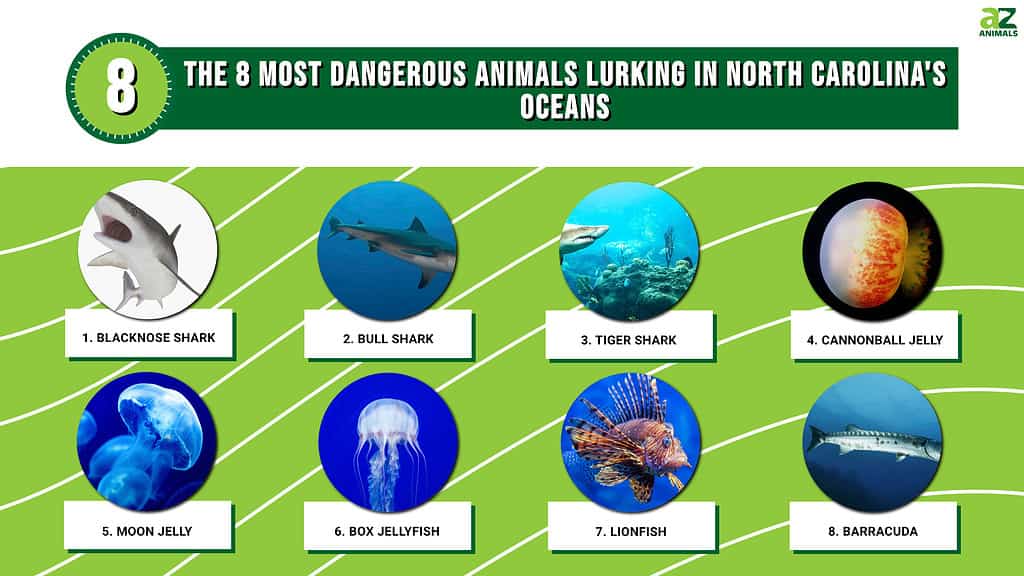
Are North Carolina’s Oceans Dangerous?

North Carolina ranks tenth for the most surf zone fatalities since 2010.
©R. L. Taubenberger/Shutterstock.com
For such a highly trafficked area, you might be surprised to learn that one of North Carolina’s beaches ranks among the top ten most dangerous beaches in the United States. According to Travel Lens, Oak Island, North Carolina, is the eighth most dangerous beach in the country. The area received a danger score of 5.53 out of 10, predominately due to the 58 hurricanes that have hit the beach since 2010. This makes North Carolina rank as the fourth highest state for the most hurricanes in the country. In addition to hurricanes, Ocracoke Island, North Carolina, ranks tenth for the most surf zone fatalities since 2010. Five deaths have been reported, which speaks to the dangerous currents off North Carolina’s coast.
While these statistics are concerning, weather conditions are predictable and avoidable. The animals that dwell off the coast, however, are much more unpredictable. In order to stay as safe as possible when visiting this state, it is important to know what to look out for. Here are the most dangerous animals in the North Carolina waters.
Sharks
When people think of the most dangerous animals in the ocean, shark attacks often come to mind. North Carolina has had three shark attacks near state beaches since 2010. While this number may not seem high, it is high compared to other state beaches. Shark attacks are rare, but these incredibly powerful creatures should be avoided at all costs. Here are the most common species of sharks found in North Carolina.
Blacknose Shark

Blacknose sharks have a bite radius of around seven inches and can be identified by a black spot on their noses.
©3DMI/Shutterstock.com
These sharks are on the smaller end, ranging from five to six feet in length and weighing between 20 and 40 pounds. They are usually found in channels and inlets around the state rather than deep waters. Blacknose sharks have a bite radius of around seven inches and can be identified by a black spot on their noses. They live in large groups and are rarely spotted alone. These sharks are not known for attacking humans but could become aggressive if provoked.
Bull Shark
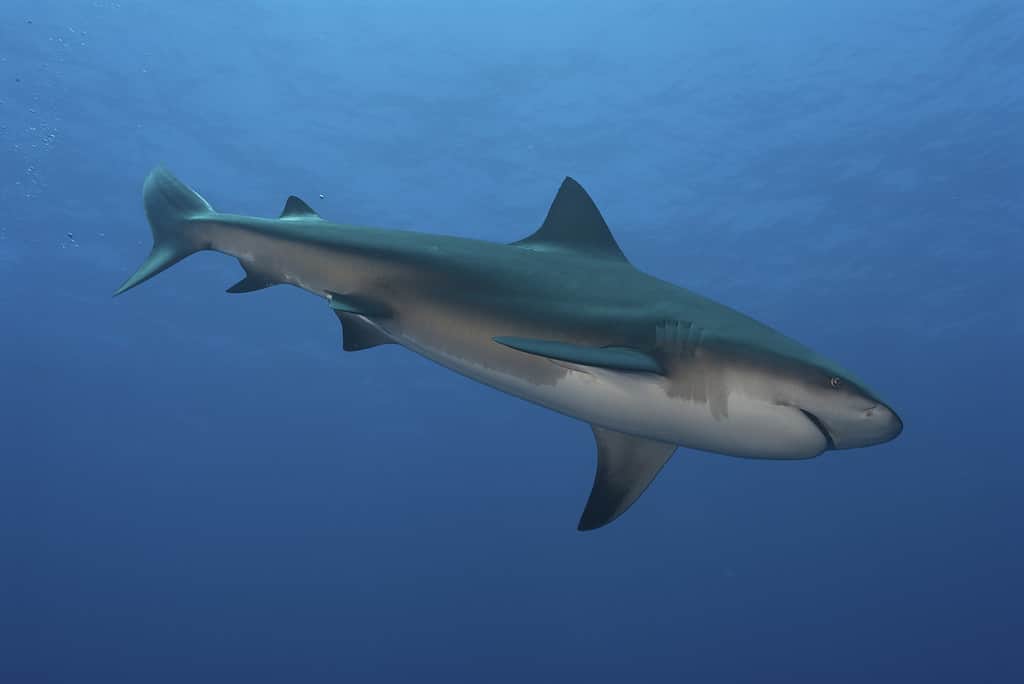
Experts often identify bull sharks as the most dangerous shark species in the world.
©iStock.com/FionaAyerst
This creature is one of the most dangerous animals on this list. Bull sharks are massive, weighing up to 500 pounds and measuring between seven and 12 feet in length. These sharks are often found near highly populated shorelines in shallow waters where humans swim. They are identifiable by their grey coloring on top and white coloring on the bottom, as well as their dark-tipped fins. Experts often identify bull sharks as the most dangerous shark species in the world. This is due to their proximity to humans and their extremely aggressive nature.
Tiger Shark
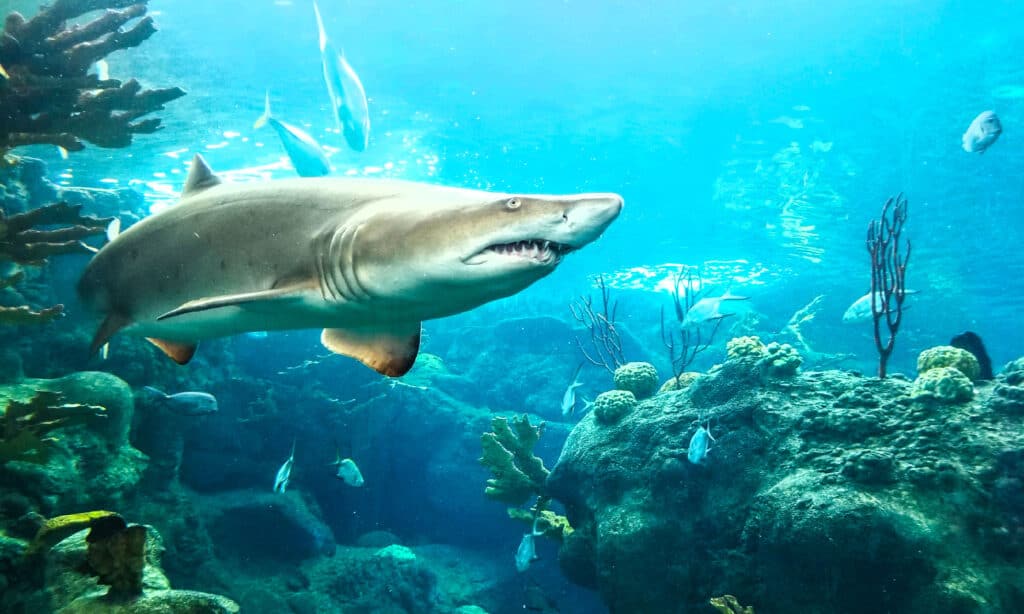
Tiger
sharks have a very weak sense of taste.
©iStock.com/Sean Craft
Weighing up to 1,400 pounds and reaching 14 feet in length, tiger sharks are the largest predators on this list. They get their name from the dark stripes that run the length of their body. However, these stripes fade with age, so they are more distinguishable by their size. Tiger sharks are incredibly aggressive, known especially for attacking humans. They are often found in coastal waters near popular beaches, such as frequented areas of North Carolina. One aspect of these sharks that makes them so dangerous is their weak sense of taste. Many sharks will bite a human out of curiosity and then swim away due to the unpleasant taste. However, tiger sharks cannot sense the abnormal human taste, causing them to continue to attack after the initial bite.
Jellyfish
Jellyfish are invertebrates, which means that they lack bones and brains. While they do not have brains and, therefore cannot be aggressive, they can still deliver painful stings. Over 30,000 species of jellyfish exist, but here are the most common ones found in North Carolina.
Cannonball Jellyfish

Cannonball jellyfish reside in shallow waters near the coasts of the southeastern United States.
©belizediversity/Shutterstock.com
The cannonball jellyfish appears more than any other jellyfish species in North Carolina. They are four inches long and around seven inches wide. These jellyfish are translucent with a blue or yellow tint and have brown spotting around the edges. Cannonball jellyfish reside in shallow waters near the coasts of the southeastern United States. When threatened, cannonball jellyfish secrete a toxin that is very harmful to small fish and other predators. Humans are not usually significantly harmed by these stings, but the toxin can cause cardiac problems.
Moon Jelly
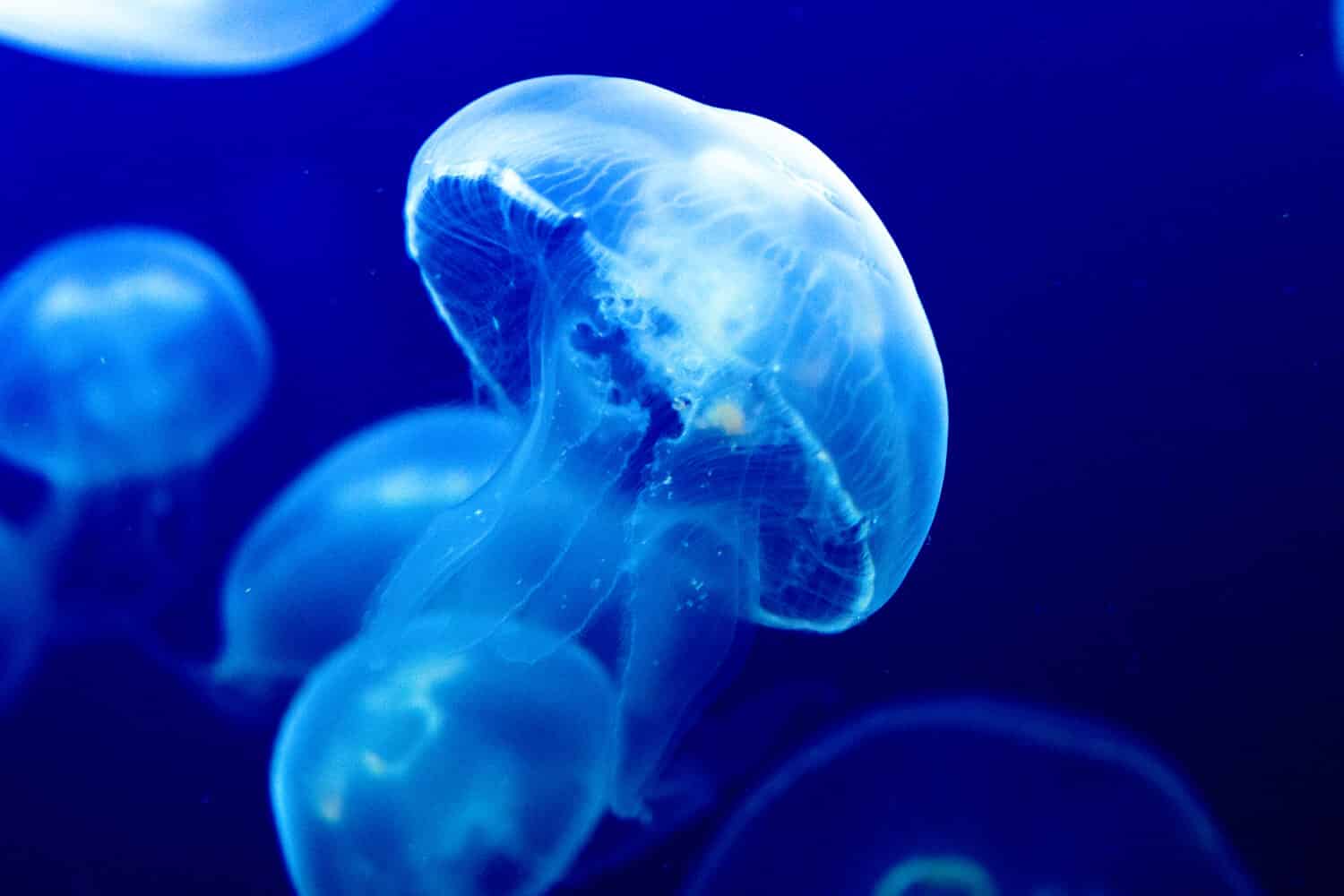
Moon jellies’ tentacles are usually only about two inches long.
©mishelo0/Shutterstock.com
The moon jelly is significantly larger than the cannonball jellyfish, reaching a diameter of up to two feet! It gets its name from the large translucent dome that covers its tentacles, reminiscent of the moon. Unlike other jellyfish, moon jellies have very short tentacles that are used to draw food into the edges of the large dome they are underneath. These tentacles are usually only about two inches long. Moon jellies are prominent in many coastal areas, including the shores of North Carolina. The stings of these fish are painful but usually not severe and will not cause serious harm. However, they should still be avoided if possible.
The Most Dangerous Animal: Box Jellyfish

Box jellyfish are by far the most dangerous jellyfish in the world.
©Danza/Shutterstock.com
The box jellyfish might be the most dangerous animal in the entire ocean. While these jellyfish are native to Australia, they frequently appear in North Carolina’s oceans. They have extremely long tentacles that can be up to 10 feet long and can weigh up to four and a half pounds. Box jellyfish are by far the most dangerous jellyfish in the world. Their stings are excruciatingly painful and can cause humans to go into shock and even die. They have cube-shaped bodies and a bluish coloring. Unlike many other jellyfish, these creatures also have developed eyes that allow them to see the waters around them. Box jellyfish are by far the most dangerous species of jellyfish in North Carolina.
Lionfish
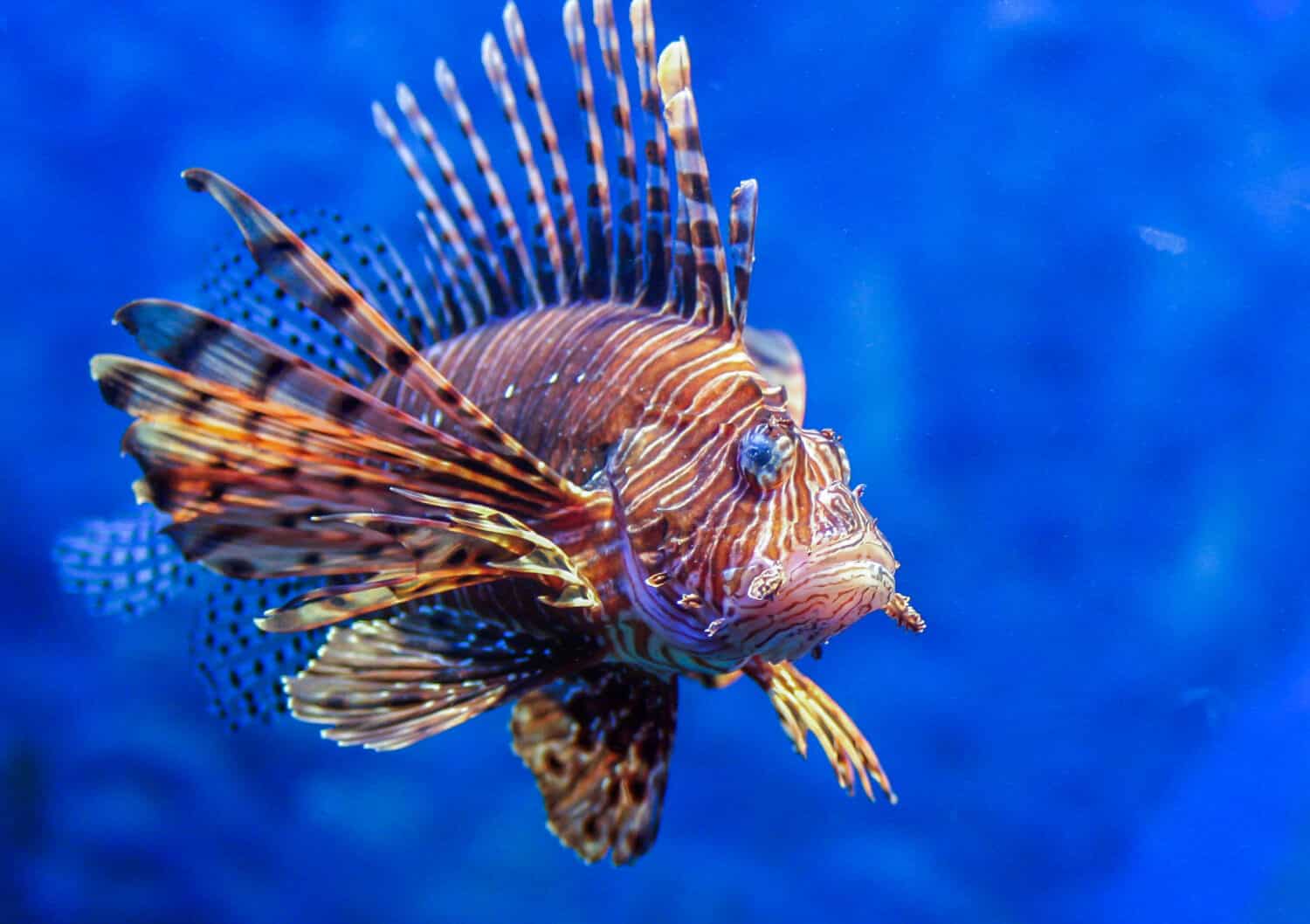
Lionfish have become an invasive species in the Atlantic Ocean.
©dimakig/Shutterstock.com
The lionfish is native to the Indio-Pacific but has become an invasive species in the Atlantic Ocean, including the coast of North Carolina. These fish are covered in brown and white stripes, and many separated dorsal spines protrude from their bodies. They are usually around a foot and a half in length. Male lionfish are known for being extremely aggressive and territorial. Their spines are used as a defense mechanism, delivering venomous stings. These stings can be incredibly painful, causing respiratory issues and even paralysis. It is recommended that medical attention be sought immediately after a lionfish sting. These stings are rarely fatal but can lead to many unpleasant and severe symptoms.
Barracuda
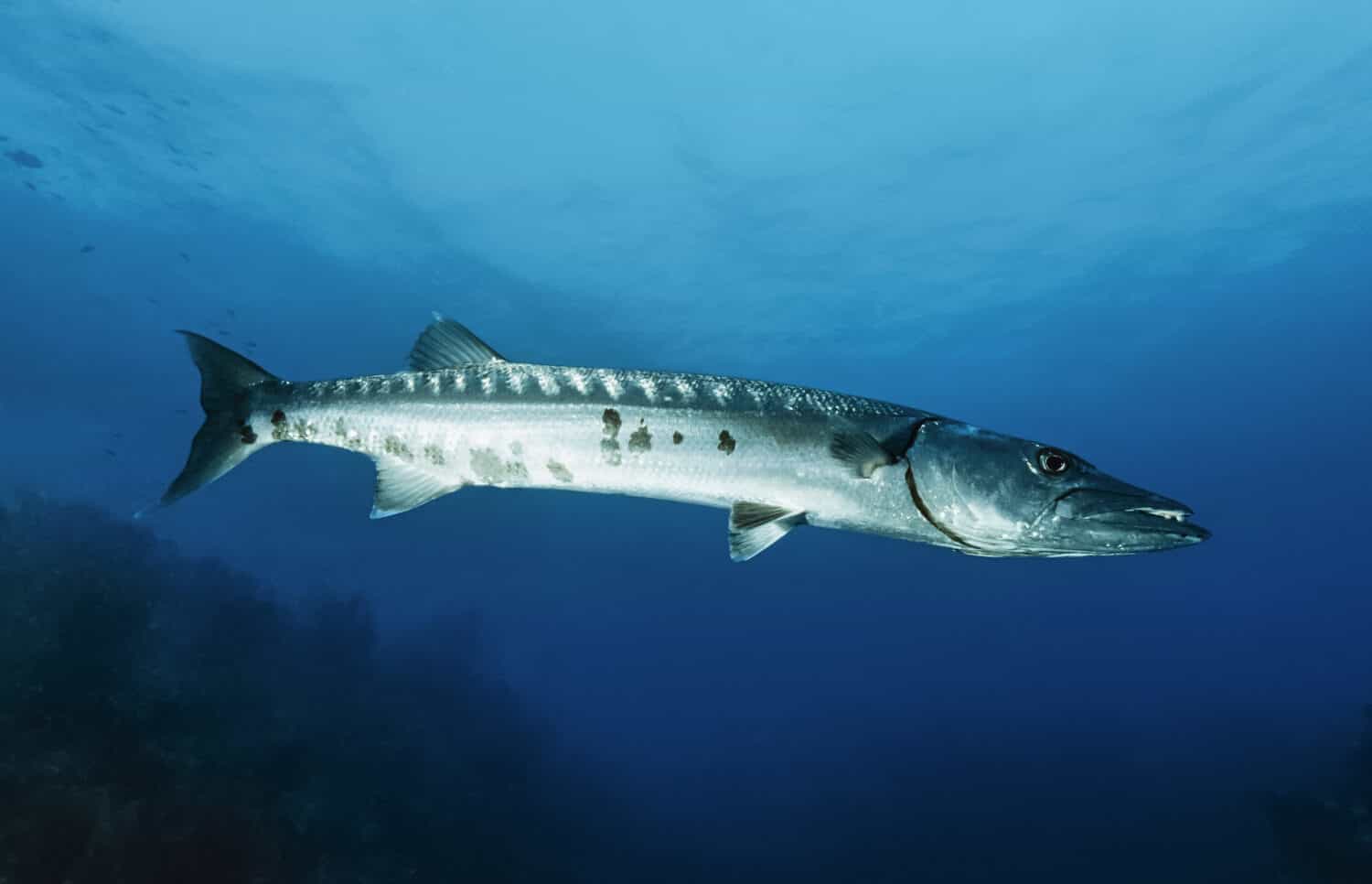
Barracudas can reach lengths of up to 14 feet!
©Angelo Giampiccolo/Shutterstock.com
One of the most dangerous animals of their size, barracudas, are found in tropical coastal regions around the globe. They prefer shallow water, meaning they are likely to encounter near North Carolina beaches. These fish have long slender bodies that are built for darting through the water at high speeds. They can reach lengths of up to 14 feet! Barracudas have a white and blue coloring that allows them to blend in with the surrounding ocean.
These fish are extremely aggressive. Several unprovoked attacks on humans have been reported, making the barracuda one fish you should certainly stay away from! Their rows of sharp teeth allow them to latch onto their prey and neutralize them quickly. These bites are fairly painful, and individuals have reported losing fingers in encounters with barracudas. Barracudas do not seek to attack humans, and their attacks are usually a result of mistaking swimmers for prey. However, it is better to be safe than sorry and stay out of the water where barracudas are present!
Summary of the 8 Most Dangerous Animals Lurking in North Carolina’s Oceans
| Number | Dangerous Animal |
|---|---|
| 1 | Blacknose Shark |
| 2 | Bull Shark |
| 3 | Tiger Shark |
| 4 | Cannonball Jellyfish |
| 5 | Moon Jelly |
| 6 | Box Jellyfish |
| 7 | Lionfish |
| 8 | Barracuda |
The photo featured at the top of this post is © Jeremy Tyree/Shutterstock.com
Thank you for reading! Have some feedback for us? Contact the AZ Animals editorial team.






